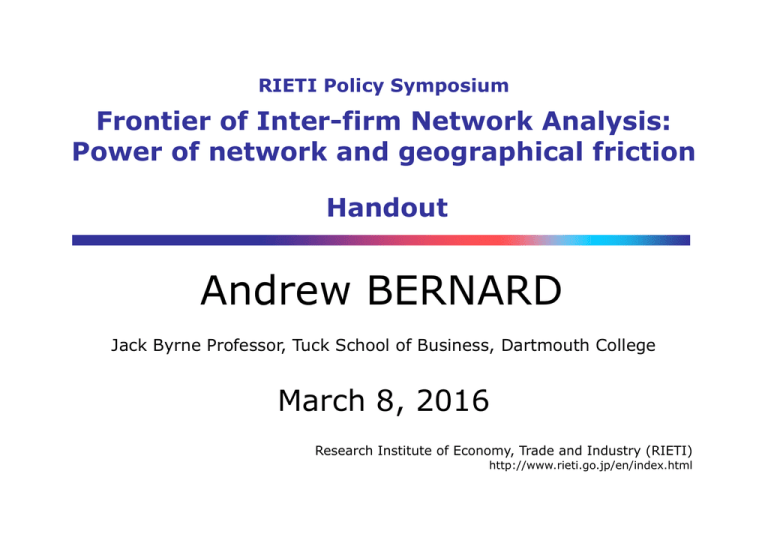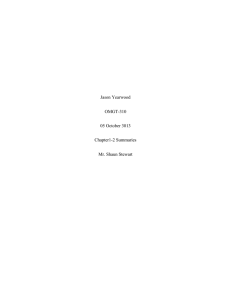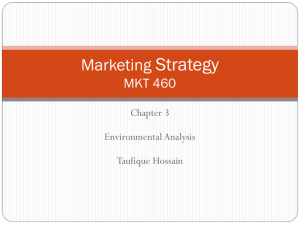Andrew BERNARD March 8, 2016 Frontier of Inter-firm Network Analysis:
advertisement

RIETI Policy Symposium Frontier of Inter-firm Network Analysis: Power of network and geographical friction Handout Andrew BERNARD Jack Byrne Professor, Tuck School of Business, Dartmouth College March 8, 2016 Research Institute of Economy, Trade and Industry (RIETI) http://www.rieti.go.jp/en/index.html Empirical evidence of firm-to-firm network in trade and its implications (Buyers and Sellers in Trade) Andrew B. Bernard Tuck @ Dartmouth, NBER and CEPR RIETI Symposium "Frontier of Inter-firm Network Analysis: Power of network and geographical friction." 08/03/2016 1 / 17 Motivation I want to challenge you to think in new ways about firms and international markets. We still are missing important components of firm behavior that distort our understanding of trade (exporting) and competitiveness. We need to expand our understanding of how buyers and sellers interact. 2 / 17 How do we typically think about exporting? A firm makes a product and decides whether or not to export that product. At the other end of the transaction is an (unmodeled) final customer who consumes the good. Important issues include: Fixed and variable costs of production Fixed and variable costs of exporting Demand/market structure 3 / 17 How do we typically think about exporting? Extensions and complications: 1 There are multiple potential export destinations. 2 Firms can and often do make multiple products. 3 Firms can sell to arms-length customers or their own related parties (Multinationals). 4 Firms might export indirectly through a wholesaler intermediary. 4 / 17 How do we typically think about exporting? The research and policy agendas and our thinking are focused on: Production Trade costs Customer In this view, firms make, price and ship their goods. 5 / 17 How should we think about exporting? Supplying firms find, or are found by, customers - typically other firms (sometimes embedded in Global Value Chains). They provide a bundle of “services”. They might “produce” all the goods in the bundle themselves. They might source the goods from others, using their own design/specifications or off-the-shelf. They might not do any “manufacturing” at all, yet not look like an intermediary. 6 / 17 How should we think about exporting? Buyers and suppliers interact in meaningful ways Either side (or both) might have market power. Interactions are likely to be repeated or quickly ended. 7 / 17 What should we do? Look for the customers and see how they matter. Who gets connected and how? How does the pairing of firms affect prices and quantities and welfare? 8 / 17 What I think I know: Manufacturing Exporters Carry-Along Trade (with E. Blanchard, I. van Beveren, and H. Vandenbussche) Manufacturers export many more goods than they produce. I They are sourcing “final” products at home and abroad The most productive firms produce and source the most goods. Standard multi-product models with sourcing cannot explain this finding. Potential explanations can come from demand or supply. I Most likely candidate is demand: demand-scope complementarities. F Purchasing firms prefer the bundle of products from one source. 9 / 17 What I want to know: Manufacturing Exporters How should we be modeling the purchase decisions of importers? I Do all buyers purchase the bundle? Who are the firms supplying these “final” goods? I Do they also export themselves? What is the evolution of produced and sourced exports? I Do firms make a good first, then find a supplier and stop production? 10 / 17 What I think I know: Buyers and Sellers Two-sided Heterogeneity and Trade (with A. Moxnes and K.H. Ulltveit-Moe) Norwegian exporters to all destinations (N) Colombian importers from all sources (C) Production Networks, Geography and Firm Performance (with A. Moxnes and Y. Saito) Japanese domestic network (J) I I I All firms with 4+ empolyees Suppliers and customers for each firm Not limited to manufacturing 11 / 17 What I think I know: Buyers and Sellers 1 The distribution of customers/suppliers across firms is close to a power law (N, C, J). I I 2 3 Larger firms reach more buyers and more suppliers (N, C, J). Geography 1 2 3 4 Many firms have one partner in a market. However, few matches are 1-1 (both firms with a single partner). The majority of connections is formed locally (J) or at shorter distances (N). Larger firms have suppliers in more locations and their distance to suppliers is higher (J). Within firms, distance is positively correlated with supplier/customer “performance” (J). Negative degree assortativity among sellers and buyers (N, C, J). 1 2 A firm with more suppliers - those suppliers have fewer customers. A firm with fewer suppliers - those suppliers have more customers. F Big firms match with big and small. Small firms match with big. 12 / 17 What I think I know: Buyers and Sellers 1 The distribution of customers/suppliers across firms is close to a power law (N, C, J). I I 2 3 Larger firms reach more buyers and more suppliers (N, C, J). Geography 1 2 3 4 Many firms have one partner in a market. However, few matches are 1-1 (both firms with a single partner). The majority of connections is formed locally (J) or at shorter distances (N). Larger firms have suppliers in more locations and their distance to suppliers is higher (J). Within firms, distance is positively correlated with supplier/customer “performance” (J). Negative degree assortativity among sellers and buyers (N, C, J). 1 2 A firm with more suppliers - those suppliers have fewer customers. A firm with fewer suppliers - those suppliers have more customers. F Big firms match with big and small. Small firms match with big. 12 / 17 What I think I know: Buyers and Sellers 1 The distribution of customers/suppliers across firms is close to a power law (N, C, J). I I 2 3 Larger firms reach more buyers and more suppliers (N, C, J). Geography 1 2 3 4 Many firms have one partner in a market. However, few matches are 1-1 (both firms with a single partner). The majority of connections is formed locally (J) or at shorter distances (N). Larger firms have suppliers in more locations and their distance to suppliers is higher (J). Within firms, distance is positively correlated with supplier/customer “performance” (J). Negative degree assortativity among sellers and buyers (N, C, J). 1 2 A firm with more suppliers - those suppliers have fewer customers. A firm with fewer suppliers - those suppliers have more customers. F Big firms match with big and small. Small firms match with big. 12 / 17 What I think I know: Buyers and Sellers 1 Dispersion of buyer expenditure matters for firm trade elasticities (N). 2 An (exogenous) reduction in search costs increases in suppliers (J). 1 An increase in suppliers raise firm performance. 13 / 17 What I want to know: Buyers and Sellers What costs matter for the matching of suppliers and buyers? How does the production network evolve? How do shocks propogate through the network? Do firms learn from their trading partners? I I I Know-how Potential customers and suppliers Potential competitors 14 / 17 What I think I know: Firms and Contracting in Trade Contracting and the Division of the Gains from Trade (with S. Dhingra) Contract choices matter in a model with two-sided heterogeneity and market power for exporters and importers. As trade costs fall, total welfare rises I but exporters and importers may change their contract choice F consumers can lose (higher prices, lower quantities, and fewer varieties) US exporters raised prices, lowered quantities and reduced import partners after the Colombia-US FTA. 15 / 17 What I want to know: Firms and Contracting in Trade How do repeated interactions affect contract choice? What market conditions lead to consumer gains/losses after liberalization? 16 / 17 Conclusions International and domestic policy is not well positioned to think about firm-to-firm connections. We still have far to go in understanding how firms interact across borders. The welfare gains of developing this understanding and formulating appropriate policy are potentially large. 17 / 17







